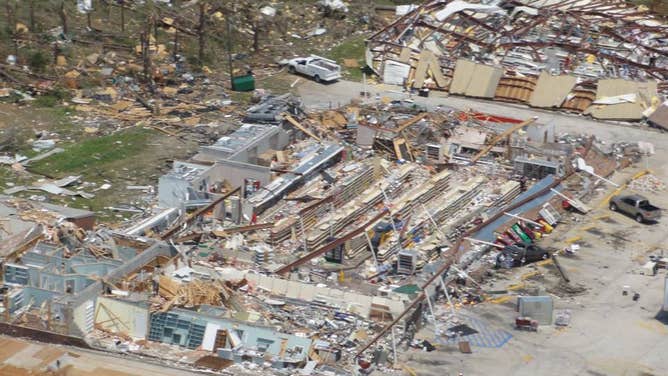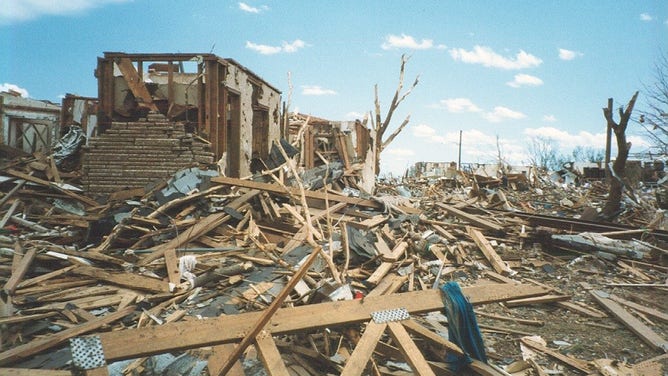Record EF-5 tornado drought extended as US marks 12 years since last one
The nation's last EF-5 tornado struck Moore, Oklahoma, on May 20, 2013, marking the longest span on record without a twister of this magnitude.
Remembering the EF-5 tornado that hit Moore, Oklahoma, in 2013
FOX Weather looks back at the devastating EF-5 tornado that hit Moore, Oklahoma, on May 20, 2013.
MOORE, Okla. – Tuesday marked 12 years since a catastrophic EF-5 tornado was last documented in the U.S., continuing what is already the longest span between "5-rated" twisters in historical records dating to 1950.
The nation's last EF-5 tornado struck Moore, Oklahoma, on May 20, 2013.
The previous record spanned nearly eight years to the day, between the F-5 twister that tore through Moore and Oklahoma City, Oklahoma, on May 3, 1999, and the EF-5 tornado that nearly wiped out the entire town of Greensburg, Kansas, on May 4, 2007. The original Fujita Scale was updated to the Enhanced Fujita Scale and implemented in the U.S. on Feb. 1, 2007.

Catastrophic damage is photographed in the days following the May 20, 2013, EF-5 tornado that struck Moore, Oklahoma.
(Doug Speheger / NWS Norman, Oklahoma)
EF-5 tornadoes are among the rarest cyclones on the planet. In the U.S., there have been only 59 EF-5 twisters since 1950, according to NOAA's Storm Prediction Center (SPC). That works out to an average of less than one EF-5 tornado in America each year. However, some years have reported multiple tornadoes of this intensity, while there have also been multiyear stretches without a single 5-rated twister, such as the current streak of 12 years.
EF-4, EF-5 TORNADOES: 7 THINGS TO KNOW ABOUT EARTH'S MOST VIOLENT CYCLONES
An EF-5/F-5 tornado has been documented in 19 states, ranging from as far north as Fargo, North Dakota, to as far south as Central Texas and as far east as Ohio near its border with Pennsylvania.
Alabama and Oklahoma have recorded the greatest number of tornadoes with a rating of 5 on the Fujita/Enhanced Fujita Scale, each with seven such twisters since 1950. Iowa, Kansas and Texas have each seen six EF-5/F-5 tornadoes.

Each placemark denotes the location of a tornado that received a rating of EF-5/F-5 on the Fujita/Enhanced Fujita Scale. Only 59 twisters have been rated this intensity since 1950.
(FOX Weather)
Leading the way with the most EF-5/F-5 tornadoes in a single year is 1974, when seven such twisters were reported during the Super Outbreak of April 3. Among that day's 5-rated tornadoes, three struck Alabama, two hit Ohio, and Indiana and Kentucky each saw one.
Just over 37 years later, six EF-5/F-5 twisters touched down in the spring of 2011. Four occurred during the April 27 Super Outbreak in Alabama and Mississippi, each reporting two EF-5 tornadoes that day. The year's other two EF-5s struck Joplin, Missouri, and El Reno/Piedmont, Oklahoma, on May 22 and 24, respectively.
HOW DOES A TORNADO OUTBREAK HAPPEN?

A Family Dollar and a Piggly Wiggly supermarket were destroyed by the Hackleburg, Mississippi, EF-5 tornado on April 27, 2011.
(NWS Birmingham, Alabama)
Any twister can turn deadly if people in its way are caught unprepared. However, those rated a 4 or a 5 on the Fujita/Enhanced Fujita Scale have historically killed the greatest number of people. In fact, 51% of all tornado deaths over the 22-year period from 2000 through 2021 were caused by EF-4 or EF-5 twisters, according to data from the SPC. The remaining 49% of the deaths were from tornadoes rated EF-0 to EF-3.
All 15 tornadoes in U.S. history that were blamed for 100 or more deaths received a rating of EF-4/F-4 or EF-5/F-5, according to the SPC.
How does a tornado receive an EF-5 rating?
A tornado is assigned a rating from 0 to 5 on the Enhanced Fujita Scale to estimate its intensity in terms of damage and destruction caused along the twister’s path.
HOW ARE TORNADOES RATED? THE ENHANCED FUJITA SCALE EXPLAINED
Meteorologists from the National Weather Service conduct storm surveys in the days following suspected tornadoes and estimate wind speeds based on the damage they observe while out in the field, using the criteria from the Enhanced Fujita Scale for guidance.
Measuring actual wind speeds inside twisters is a difficult feat because any weather instruments placed in their path are likely to be destroyed.
In order for a tornado to receive an EF-5 rating, the NWS says the damage must be catastrophic. Winds in an EF-5 twister are greater than 200 mph.

Catastrophic damage is photographed in the days following the May 3, 1999, F-5 tornado that struck Moore and Oklahoma City, Oklahoma.
(NWS Norman, Oklahoma)
WHEN IS AMERICA'S MOST ACTIVE TIME OF YEAR FOR TORNADOES?
EF-5 tornadoes will destroy well-built frame houses and sweep their foundations clean of debris. In addition, steel-reinforced concrete structures will be critically damaged, and tall buildings will collapse or have severe structural deformations. Cars, trucks and trains can even be tossed up to a mile away.
